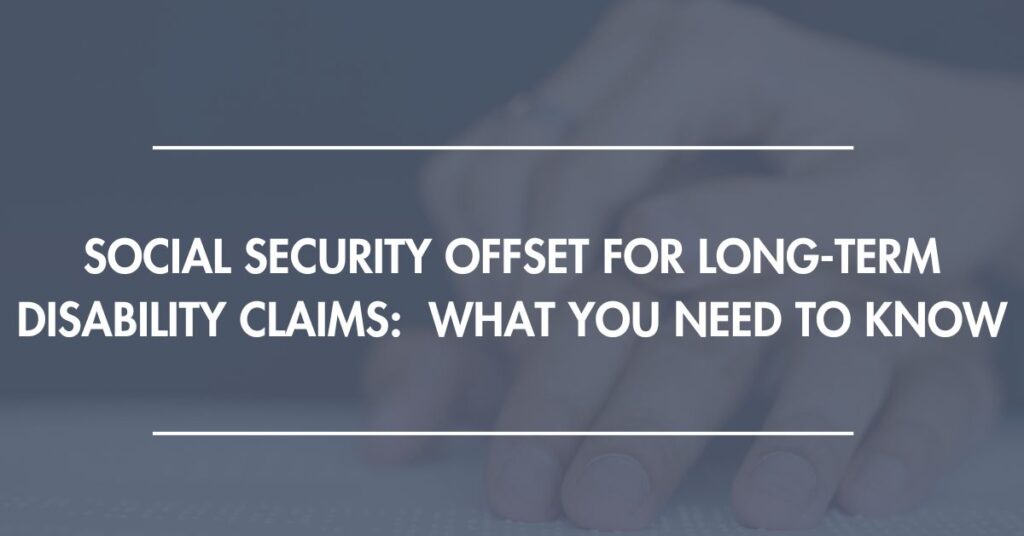
If you were diagnosed with a chronic illness or suffered a significant injury that left you disabled and unable to work, you may be eligible for long-term disability (“LTD”) benefits. Receiving LTD benefits means you get a percentage of your pre-disability income. However, these benefits come with a potential catch – there may very well be a provision under your long-term disability policy allowing for a reduction of your disability benefits based on other sources of income. This reduction is generally referred to as an “offset.” One of the most common offsets of long-term disability benefits is when someone is also receiving Social Security Disability Insurance (“SSDI”) benefits.
Interplay Between Long-Term Disability Benefits and Social Security Benefits
It is quite common for long-term disability policies to contain provisions requiring you to apply for SSDI benefits. For context, SSDI benefits are government-funded disability benefits. Conversely, long-term disability benefits are paid out through an insurance provider. Individuals are typically eligible to apply for, and receive, Social Security benefits when they have paid Social Security taxes on work earnings, have worked for a certain amount of time, and meet their definition of total disability. LTD disability benefits are accessible through a specialized type of insurance policy designed to cover a percentage of your income if you are unable to work for an extended period of time. The duration of LTD benefit payments will depend on the terms of your policy.
Why would your long-term disability policy require you to apply for SSDI benefits? Answer: To allow your insurance company to offset your long-term disability benefits with the amount you may receive via SSDI. The mandatory SSDI application is effectively the insurance company’s way to ensure someone is not “double dipping” and receiving multiple benefit payments for the same disability.
It is important to note that simply applying for SSDI benefits does not guarantee you will actually receive SSDI benefits. In fact, getting approved for SSDI benefits can be extremely difficult due the program’s strict requirements and narrow definition of what is considered a “total disability.” If your SSDI application is denied, your long-term disability insurance carrier may require you to exhaust your administrative appeals.
Please note that, while extremely common especially in employer sponsored (ERISA) disability policies, not every LTD policy includes a Social Security offset provision. The terms of each policy can vary.
Applying for Both LTD Benefits and SSDI Benefits
Despite the compulsory nature of applying for SSDI to be eligible to receive a full LTD benefit, it generally makes sense to pursue financial benefits under both SSDI and an applicable LTD benefits policy. Why? Because SSDI payments are generally lower than payments from an LTD insurance policy. This means if you opt not to apply for LTD benefits and try to rely solely on SSDI benefits, there is a risk you could be left struggling financially to cover important expenses.
Additionally, even if your Social Security benefit won’t result in an increase in the amount of money you receive monthly, SSDI comes with other important benefits like medicare health insurance, and auxiliary benefits for children. Social Security benefits also aren’t subject to common clauses in LTD policies like an “own occupation” limited pay period, or a 24-month limitation for disabilities based on mental health.
Even if your LTD payments are offset by SSDI, you will likely receive more income coverage under both SSDI and LTD benefits than under the SSDI program alone. It is also important to note that the approval period for Social Security benefits can be lengthy, and long-term disability benefits can provide coverage during this interim approval period.
Figuring Out How Your SSDI Offset Will Impact Your LTD Payments
If your SSDI application is approved and you are receiving LTD benefit payments, then it is important to monitor how your LTD insurance company begins to offset disability benefit payments. For example, it is recommended to review your LTD insurance policy to be aware of how Social Security Disability Insurance works within your specific plan and to make sure the insurance company is calculating the offset correctly (do not take their word for it).
It is also important to be aware of the ways SSDI payments can lower your LTD benefit payments. One potential issue to be aware of is something known as a “double offset.” This situation arises when an individual is covered under two or more LTD insurance policies. If both policies provide for an offset of SSDI benefits, you are at risk of incurring a double offset, and you may receive less disability income than planned.
For example, let’s say you have two long-term disability policies that each pay out $4,000 per month. This means you would expect $8,000 of monthly disability income. However, if each LTD policy provides for an SSDI offset, and your SSDI benefit was $2,000 per month, courts have decided that the insurance carrier is authorized to take an SSDI offset from both policies. This means your $8,000 monthly benefit would be offset and reduced to $6,000 per month (i.e., $2,000 offset from each LTD policy, while receiving $2,000 from SSDI).
Have Questions About the Social Security Offset for Long-Term Disability Benefits? Contact Bross & Frankel
If you have questions about your long-term disability benefits being offset by SSDI, then contact Bross & Frankel. We are here to help. Our team of experienced long-term disability attorneys understand the complexities of the disability benefits system and can advise you of the potential impact associated with a social security offset. Contact us or call us today at (856) 795-8880 for a complimentary consultation.
Additional Resources
- Can You Collect Social Security and Long-Term Disability?
- Long-Term Disability Eligibility Requirements
- Applying for Social Security Disability Benefits

Rich Frankel is the managing partner of Bross & Frankel. He is a member of the New Jersey and Pennsylvania bars. He has focused exclusively on disability and social security benefits since 2005.
Mr. Frankel joined what is now Bross & Frankel after having watched his father struggle with disability, fighting a lengthy illness. Mr. Frankel founded the firm’s veteran’s law practice and substantially grew the social security disability practice, focusing Bross & Frankel’s ability to fight for all of the disability benefits available to his clients.
Mr. Frankel additionally fights for clients in court, obtaining frequent victories in Social Security appeals and against insurance companies in Federal court.